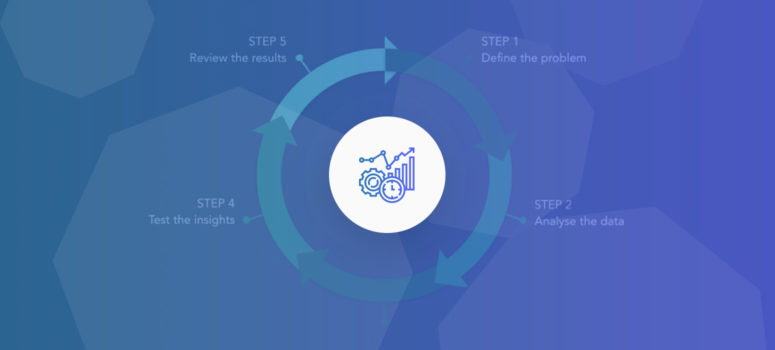The data-driven decision-making framework is perhaps the most powerful business hack I’ve ever come across in my entire career.
What is data-driven decision making?
The term ‘data-driven decision making’ can be defined in many ways. In this article, I’ll be focusing on how it can be applied to your marketing & business decisions.
A quick tip: the data-driven decision-making framework doesn’t just apply to marketing only. You could go as far as saying it can be applied to your life decisions – and most definitely business decisions.
My framework for data-driven decision making
Step one: Define the problem that you are facing
Step two: Gather the data & evidence that directly or indirectly relates to the problem at hand. Analyse the data so you can develop an understanding of what it means.
Step three: Once you’ve answered the ‘what’ by analysing the data, develop an insight as to ‘why’ the problem is happening.
Step four: Develop a hypothesis from your insight that answers ‘how’ you can test your assumption. It’s important to note that we are not coming up with the solution here. We are simply coming up with a case to test to see if our insights & assumptions actually solve the problem.
Step five: Now that I’ve tested my hypothesis, what are the results and outcomes? Have I solved the problem? Have I made the problem worse? Or, has the problem changed & evolved?
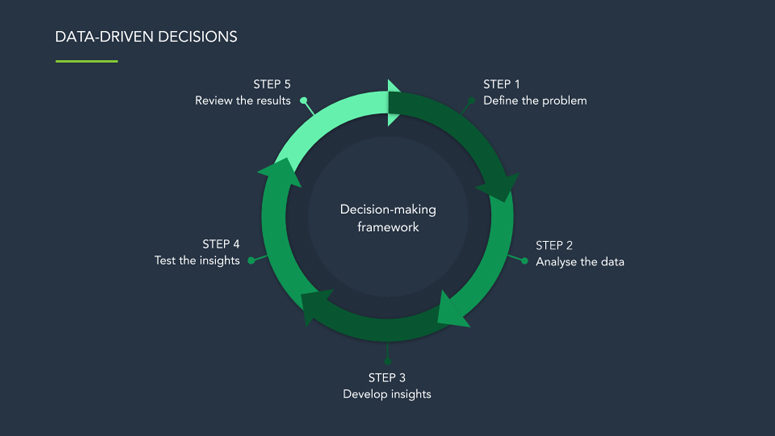
If the problem still exists or has gotten worse, repeat these five steps until you resolve it.
The key thing to understand is the data-driven decision-making process is not linear. Rather than having a certain endpoint, it should be seen as a cyclical process of continuous improvement.
Once you launch your website, every change that you consider making to it should be processed through this decision-making framework.
That way, the changes you are making will only ever lead to ongoing improvement. While at the same time, it reduces the chance of making changes that will negatively affect your website’s performance.
Applying the data-driven decision-making framework to online marketing
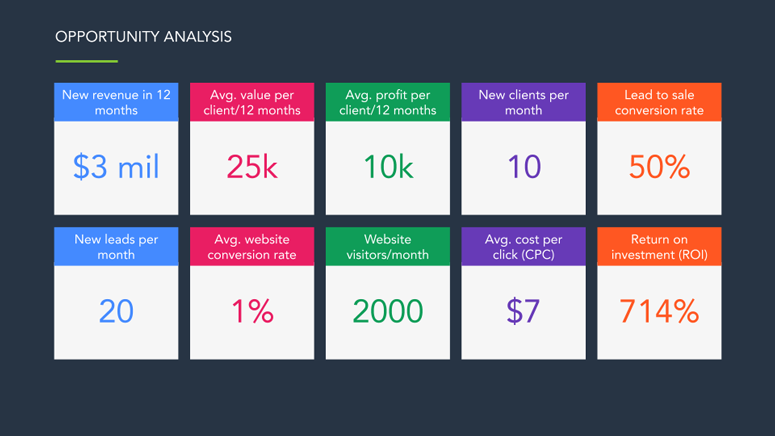
To best describe this, I’ll show you some examples of search advertising campaign problems that we’ve solved for us and our clients at Web3.
Example one – “I’m not making any money from my advertising campaign!”
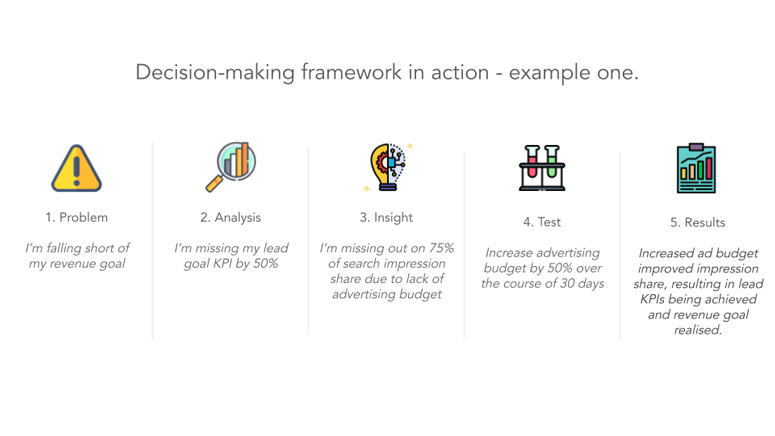
1. Problem: I’m falling short of my revenue goal.
2. Analysis (the what): I’m missing my monthly lead acquisition goal KPI by fifty per cent.
3. Insight (the why): I’m missing out on seventy-five per cent of my search impression due to a lack of advertising budget compared to my closest bid competitors.
4. Test (the how): I’m going to test increasing my advertising spend by fifty per-cent of the course of a month to see if I can increase my search impression share.
5. Result: Increasing my advertising budget resulted in a 100% increase in search impression share, resulting in my lead acquisition goal KPI being achieved. I have compared these results against my return on adverting spend (ROAS) and return on investment (ROI) figures for the last 30 days compared to the previous month, and I can see improvements here as well.
Example two – “I’m getting mostly tire-kickers with low budgets from my marketing campaign!”
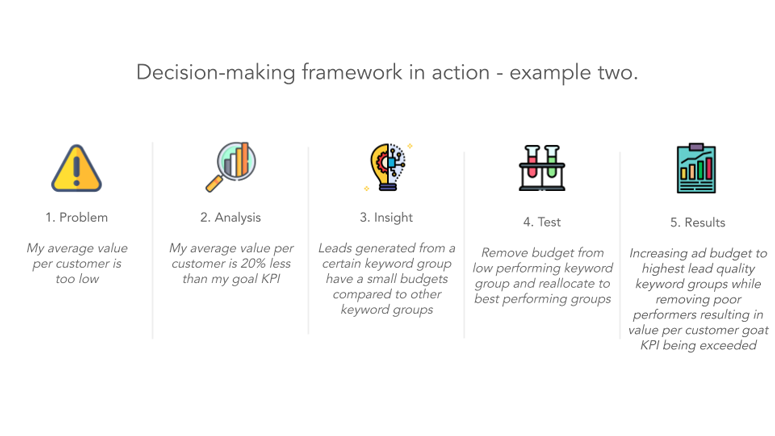
1. Problem: My average value per customer is too low
2. Analysis: My average value per customer is twenty per cent less than my goal KPI.
3. Insight: Leads generated from certain keyword groups have small budgets compared to leads that have come from the other keyword groups.
4. Test: I’m going to move the adverting spend from my keyword groups that are resulting in low budget leads and redistribute that advertising spend to my keyword groups that are resulting in leads with healthy budgets.
5. Result: Redistributing the overall advertising budget to the keyword groups that are producing the highest quality leads resulted in my average value per customer goal KPI being exceeded by 15%.
Example three – “My website isn’t converting!”
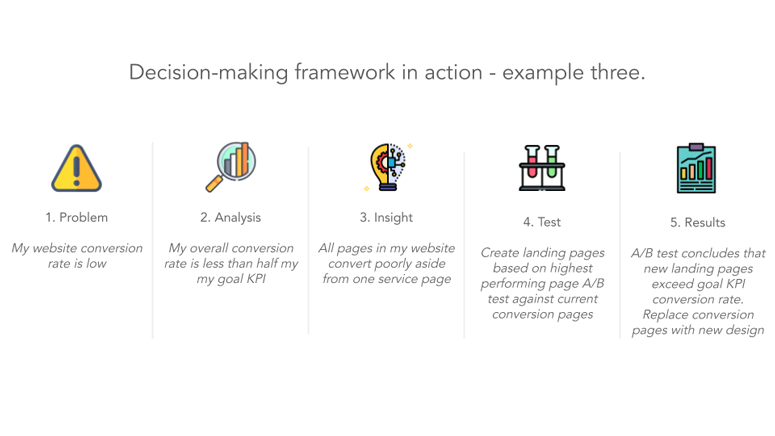
1. Problem: My website conversion rate is too low
2. Analysis: My website conversion rate is less than half of my goal KPI
3. Insight: All pages in my website convert poorly, aside from one particular service page.
4. Test: I’m going to create landing pages based on my highest performing service page. Then, I will A/B split test these landing pages against my current source of conversion pages.
5. Result: The A/B split test concludes that the new landing page exceeded the goal KPI conversion rate. I’m now going to replace all previous conversion pages on my website with the winning landing page examples.
Example four – “It’s costing me too much money to acquire a new client!”
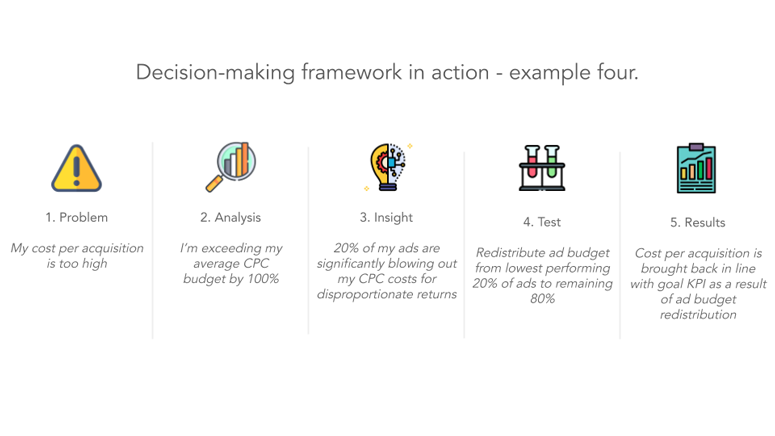
1. Problem: My cost per acquisition (CPA) is too high
2. Analysis: I’m exceeding my average cost per click (CPC) budget by one hundred per cent, resulting in a lack of clicks to my sources of conversion.
3. Insight: Twenty per cent of my ads are significantly blowing out my cost per click goal KPI and are producing disproportionate returns.
4. Test: I’m going to now test redistributing my advertising budget from the twenty per cent of ads that are producing disproportionate returns to my remaining eighty per cent of ads.
5. Result: My CPA is brought back in line with my goal KPI as a result of the redistribution of the budget.
Applying data-driven decision making beyond marketing
An important takeaway here is if you don’t have the data, it makes it very difficult to come up with solutions. This applies to both problems you are trying to solve in your business, as it does to your website & marketing efforts.
You can get around this issue by ensuring that all the data you need to make effective decisions is tracked & measured accurately with the right tools.
Once you have the data, you’re processing it through a data-driven decision-making framework to resolve these solutions faster & easier than if you were simply making seat-of-the-pants decisions.
Don’t get me wrong – there are cases where the only type of decision you can make is by the seat-of-the-pants. I’m certainly not saying to not trust your gut instincts!
But if we’re talking about major decisions, such as redesigning your entire website because you are not happy with it, you should consider collecting evidence against your issue, analysing the evidence to develop insight & hypothesis to test before committing to a decision that will result in a large outlay of time and money.
The reality with marketing is the problem that you are trying to fix is often never resolved on the first attempt. In fact, your tests will more often than not result in failure than success.
In most cases, it takes multiple iterations (along with multiple failures along the way) before you can reach a satisfying outcome.
That’s why processing your decisions quickly & efficiently through a data-driven decision-making framework is so important. That way, you can get the results you are chasing sooner rather than later.
What are your thoughts on data-driven decision making? Let me know your thoughts in the comments section below!

